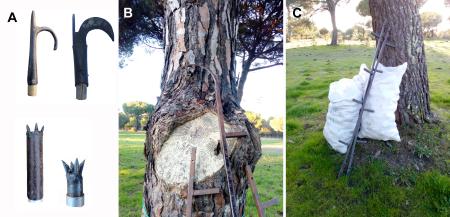
Objective:
Stone pine (Pinus pinea L.) cone harvesting in Portugal continues to occur trough the traditional way, that is, by specialized workers that climb the trees and remove the cones by hand using special tools.
Here we intend to document photographically this traditional knowledge, present the various tools used by cone pickers in the harvesting process and the materials used to build them. This information can be potentialy usefull in other coutries were cone harvesting is made by small, locally operating family firms.
Context:
Cone harvesting in Portugal takes place legaly from the months of December to March when the cones reach full size and weight and the pine nuts are completely developed.
The field teams are constituted by the climbers (usualy man) that pick the cones from the trees and operators (usualy women) that colect the felled cones and bag them. Usualy there is a person coordinationg the work.
In an 8-hour working day, a climber is able to pick about 400 kg of cones (fresh weight). It is possible to harvest between 10 and 20 medium-sized trees per day, although this amount depends on the size of the crowns and the number of pine cones in the tree.
Contacts:
Alexandra Correia, alexandrac@isa.ulisboa.pt, https://alexandracorreia.wixsite.com/curriculum
Further information:
Estudo sobre a cadeia de valor da fileira Pinha/Pinhão (Pinus pinea L.), Edição: UNAC – União da Floresta Mediterrânica, Autor: Agri-Ciência – Consultores de Engenharia, Lda. (2014). http://www.unac.pt/index.php/documentos/publicacoes/45-cadeia-de-valor-da-fileira-da-pinha-pinhao/file
This factsheet was developed under the operational groups:
FERTIPINEA – Nutrição e fertilização do pinheiro manso em sequeiro e regadio
+Pinhão – Gestão integrada de agentes bióticos associados à perda de produção de pinhão
Financed by PDR2020 (Programa de Desenvolvimento Rural 2014-2020); Parceria n.º 52/ Iniciativa n.º 81, Ação 1.1 Grupos Operacionais promovida pelo PDR2020 e cofinanciada pelo FEADER, no âmbito do Portugal 2020.